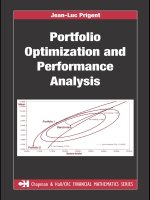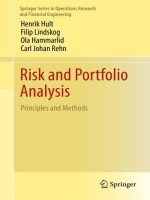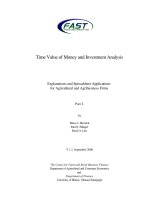Combining Fundamental And Technical Analysis potx
Bạn đang xem bản rút gọn của tài liệu. Xem và tải ngay bản đầy đủ của tài liệu tại đây (135.23 KB, 17 trang )
Combining
Fundamental And Technical
Analysis
1
st
edition (April 2008)
By
Yulianto
www.stockpickguide.com
Copyright © 2008
All Rights Reserved
@ 2008 – www.stockpickguide.com . All rights reserve worldwide 1
Preview
There has been many discussion about which strategy is better, fundamental analysis
or tehcnical analysis. Technical aproach has been reinforced by trading software
which can be used to predict price based on price simulation, where it uses models for
each market without regard the underlying economy or fundamental which driven the
market. Several recently developed programs help boil down the maze of economic
and fundamental information into a form useful by traders who do not have formal
training in economics. These programs help track the impact that economic indicators
have on price in various markets. Such software gives traders an easy-to-understand
link between fundamental data and price.
The technical analysis is easier to use than fundamental. But when the market
crash on October 1987, traders started to pay attention on the fundamentals, like
unemployement figures, trade deficit, unemployment, and commodity supply/demand
data . With the combination of two strategy, we will have quite a powerfull strategy.
Technical analysis tells us when the price will likely move, while fundamental
analysis tells us what stock is good. By combining the two strategy, we can have a
good stock which the price will likely move.
In this ebook, I want to combine the two stategy to make a new strategy, the
combination on fundamental and technical analysis. A trading plan is needed to win
the battle win other investor. You need to know how to choose a good stock, and how
to choose a stock which will move in favor of us shortly.
@ 2008 –
www.stockpickguide.com . All rights reserve worldwide 2
Content
Disclaimer 4
Fundamental Analysis 5
•
••
•
Cheap 6
•
••
•
Safe 8
•
••
•
Profitable 9
Technical Analysis 10
•
••
•
Momentum Investing 11
•
Volume 13
Case 16
@ 2008 –
www.stockpickguide.com . All rights reserve worldwide 3
Disclaimer
The opinions provided herein are intended to inform. They come with no warranty of
any kind. If you should choose to interpret this information as investment advice, you
do so at your own risk. Investing can be a very dangerous venture and it is you who
must assume the entire cost and risk involved in all of your investment decisions,
should you choose to follow this advice or use this information.
@ 2008 –
www.stockpickguide.com . All rights reserve worldwide 4
Fundamental Analysis
Fundamental analysis is analysis by looking at the company's fundamental, like
its financial condition, and profitability. Using fundamental analysis we want to
find the fair value of a company. The calculation is done by using the time of
money concept, which is money now is better than money in the future. By
knowing how is the cash flow, the in and out of money, you can count for it’s fair
price. That’s the difficult thing to do, because you need to predict how much profit
will the company make.
The easiest way to do this is to get valuation from your investment firm. They
usually have their own research department, and can give you the target price or
fair price of a stock. The hard way is to calculate the fair price by your self. To do
this, you will need good financial knowledge, and master the industry condition.
Choosing big companies with good fundamental, finance performance will bring
lower risk, but not always high return. The analysis can be done using economic
indicators such as GDP, inflation, interest rate, and oil price.
This strategy is done by selecting cheap / undervalue stock that the corporate
has low risk, and good profitability.
@ 2008 – www.stockpickguide.com . All rights reserve worldwide 5
Fundamental Analysis-CHEAP
To find a cheap stock you need to know its fair value. It the current price is lower than
its fair value, then you got your self a cheap stock. Cheap stock does not mean it has
low dollar value. A $100 stock is called cheap if its fair value is $200, grater than it's
current price. A $1 stock is called expensive if its fair value is $0.5, lower than it's
current price.
A simple way to find out if a stock is cheap or not is by looking at it's P/E (Price /
Earning) ratio. The P/E ratio is a measure of the price paid for a share relative to the
profit per share.
A higher P/E ratio means that investors are paying more for each unit of income. The
price per share (numerator) is the market price of one stock. The earnings per share
(denominator) is the net income of the company for the most recent 12 month period,
divided by number of shares outstanding. Investors can use the P/E ratio to compare
the value of stocks. If one stock has a higher P/E that of another stock in the same
industry, all things being equal, it is a less attractive investment. Normally, stocks
with high earning growth are traded at higher P/E values, because investor anticipate
the high growth.
A more advance ratio fom PE is the PEG ratio. The Price/Earnings To Growth, is a
valuation metric for determining the relative trade-off between the price of a stock, the
earnings generated per share (EPS), and the company's expected growth. A lower ratio
is "better" (cheaper) and a higher ratio is "worse" (expensive). A PEG ratio that
@ 2008 –
www.stockpickguide.com . All rights reserve worldwide 6
approaches two or goes higher than 2 is believed to be too high. This means that the
price paid is to be much higher relative to the projected earnings growth.
The PEG ratio of 1 represents a fair value between the price and the company's
growth. Similar to PE ratios, a lower PEG means that the stock is undervalued more.
If a company is growing at 30% a year, then the stock's P/E could be 30 to have a PEG
of 1. PEG ratios between 1 and 2 are therefore considered to be in the range of normal
values.
Defining the projected growth rate is difficult. It will be wise enough to use
reasonable future growth rate by checking quarter's earnings have grown, as a
percentage, over the same quarter one year ago.
PEG ratio is use suitable for high growing company and is less appropriate for
measuring companies without high growth. Large, well-established companies, for
instance, may offer dividend income, but little growth. This dividend will affect price
and PEG ratio.
PEG is a widely used indicator of a stock's potential value. It is favored by many over
the price/earnings ratio because it also accounts for growth. Similar to the P/E ratio, a
lower PEG means that the stock is more undervalued.
Keep in mind that the numbers used are projected growth and therefore can be less
accurate.
@ 2008 –
www.stockpickguide.com . All rights reserve worldwide 7
Fundamental Analysis - Safe
To measure the safety of a company, we use the debt to equity ratio (D/E). It is a
financial ratio indicating the relative proportion of equity and debt used to finance a
company's assets. This ratio is also known as Risk or Gearing. It is equal to total debt
divided by shareholders' equity. The two components of debt and equity are often
taken from the firm's balance sheet, but the ratio may also be calculated using market
values for both, if the company's debt and equity are publicly traded, or using a
combination of book value for debt and market value for equity.
A high debt/equity ratio generally means that a company has been aggressive in
financing its growth with debt. This can result in volatile earnings as the result of
interest expense. If a lot of debt is used to finance increased operations, the company
could potentially generate more earnings. If this earnings is greater than the debt cost
(interest), then the shareholders will benefit. However, if the cost of this debt
outweigh the return that the company generates on the debt through investment and
business activities, the company can go bankrupt.
The debt/equity ratio depends on the industry in which the company operates. For
example, capital-intensive industries such as auto manufacturing tend to have a
debt/equity ratio above 2, while personal computer companies have a debt/equity of
under 0.5.
@ 2008 –
www.stockpickguide.com . All rights reserve worldwide 8
Fundamental Analysis - Profitable
The ROE is useful for comparing the profitability of a company to that of other firms
in the same industry. ROE measures a company's profitability by comparing its net
income to shareholders equity (book value). ROE is a speed limit on self-funded
growth (company's profit). That is, a company cant grow earnings faster than its ROE
without raising cash by borrowing or selling more shares. For instance, a 15% ROE
means that the company cant grow earnings faster than 15% annually by relying only
on profit to fuel growth.
Higher ROE is usually better. ROE, then, becomes a measure not only shows return of
the company is generating, but also of how successfully management has been in
running the corporation. Good ROE ratio depends on the company's industry. When
looking for stocks, we want to find companies that show an increasing ROE over
time. It's a sign to us that management is getting better and better at deciding what to
do with its money. The higher the number, the better management has allocated
capital.
It turns out that a company cannot grow earnings faster than its ROE without raising
additional cash. That is, a firm with a 15 percent ROE cannot grow earnings faster
than 15 percent annually without borrowing funds or selling more shares. So ROE is a
speed limit on a firm’s growth rate. Many specify 15 percent as their minimum
acceptable ROE when evaluating investment candidates.
You also must pay attention on the company's debt when calculating ROE. Recall that
shareholder’s equity is assets less liabilities. High liabilities means low equity. The
higher-debt firm will then show the higher return on equity. Consequently, you should
take debt levels into account when comparing different firm’s return on equities.
@ 2008 –
www.stockpickguide.com . All rights reserve worldwide 9
Technical Analysis
Technical analysis is done by looking at previous price, and volume data.
Technical analyst look at past chart of price and different indicator to make
prediction about the future prices. The human emotion is an important aspect
here. Their willingness to buy stock at a certain price will determine future price.
This analysis assumes that price moves at trend, and history repeats itself. It is
believed that this analysis is more art than science. Because of that, there has
been plenty of critics to this analysis, due to lack of evidence of it's performance.
But it is still a popular method in the world, through its easiness. Critics also
came from well known fundamental analyst, Warren Buffet. It is also inconsistant
with market hypothesis, like Efficient Market Hypothesis (EMH) and Random Walk
Hypothesis.
The most popular method used in this analysis is volume, support and
resistance, bollinger band, moving average, momentum, stochastic
oscillator and indicator such as MACD.
There are a lots of technical analysis used. But here, I want to emphasize
momentum investing and volume.
@ 2008 – www.stockpickguide.com . All rights reserve worldwide 10
Technical Analysis - Momentum
Momentum investing is a system of buying stocks or other securities that have had
high returns over recent times. The basic is if a stock is having a up momentum, price
going up, it usually goes up more until one point. It has been reported that this strategy
yields average returns of 1% per month for the following 3-12 months as shown by
Narasimhan Jegadeesh and Sheridan Titman. Momentum investors try to seek out
stocks with the potential to double or triple within just a few months.
You can see momentum investing was on the dot-com stocks. The prices of these
stocks seemed to rise for no good reason, despite lack of earnings or sometimes
even the prospect of earnings. The price of the stock keep going up until it burst.
As momentum investors see a rising trend, they all join in, driving prices even higher.
It may seem like a winning strategy, with the promise of high upside and limited
downside. But the risk of this strategy is that, while momentum investors can all pile
in at the same time, they cannot all sell at the same time unless markets are both
highly liquid (easy to sell because many people want to buy) and continuous (prices
do not gap sharply downward with no opportunity to sell).
When there is no good fundamental on the stock, it can go down very quickly. When a
bad news comes out, previous buyers will try to get out. The stocks become highly
illiquid and prices become discontinuous. This will drive prices lower and also leads
to margin calls, and thus more selling. This happened when technology and dot-com
bubbles burst in March 2000.
What do they look for in momentum investing?
Momentum investing usually looks for rapid earning growth or recent positive
changes in earnings-growth forecasts. Earnings momentum starts with strong quarterly
year-over-year earnings growth. Momentum investors also looks for a positive
earnings surprise in the last reported quarter, meaning that the reported earnings
@ 2008 –
www.stockpickguide.com . All rights reserve worldwide 11
exceeded the forecasts.
Momentum investing is not a buy-and-hold strategy. Momentum investors typically
hold a stock for a few weeks / months. However, they usually monitor their holdings
daily.
When to sell
Momentum stocks get hammered when something goes wrong. Consequently,
momentum investors must act quickly at the first sign of trouble. When there is bad
news coming out, that's the sign to sell, especially when the price go down quickly
with big volume.
Final note
Momentum investing is risky, and requires close attention and discipline. When price
go down, think that it can go down further, not it can go up again.
@ 2008 –
www.stockpickguide.com . All rights reserve worldwide 12
Technical Analysis – Volume
Volume is an important aspect of technical analysis because it is used to confirm
trends. Trading volume is the number of shares traded daily, on average. Any price
movement up or down with relatively high volume is seen as a stronger, more relevant
move than a similar move with weak volume. For example, that a stock jumps 5% in
one trading day with high volume, usually goes up again the next day. If the volume is
below average, there may not be enough conviction to support a trend reversal.
Volume should move with the trend. For example, if the stock is in an uptrend but the
up trading days are marked with lower volume, it is a sign that the trend is starting to
lose its legs and may soon end.
Very low trading volumes signal lack of interest. The higher the volume, the more
active the security. Low volume levels are characteristic of consolidation periods
(prices move sideways). High volume levels are characteristic of market tops when
there is a strong consensus that prices will move higher/lower. High volume levels are
also very common at the beginning of new trends. Just before market bottoms, volume
will often increase due to panic-driven selling.
Volume can help determine the health of an existing trend. A healthy up-trend should
have higher volume on the upward price, and lower volume on the downward price. A
healthy downtrend usually has higher volume on the downward price and lower
volume on the upward price. Volume is closely monitored by technicians and chartists
to form ideas on upcoming trend reversals. If volume is starting to decrease in an
uptrend, it is usually a sign that the upward run is about to end.
@ 2008 –
www.stockpickguide.com . All rights reserve worldwide 13
From the image above, there are two signal. One is a sell signal, and the other one is
the buy signal. The line char shows price, while the bar chart below shows volume.
The sell signal occurs because the price went down with high volume on November.
The stock eventually went down until January. In that month, there is a buy signal,
because price was up with high volume. The stock price then rally until the next
month.
Accumulation and distribution
Accumulation is when the market is controlled by buyers. A down-trend that stalls
while volume remains high signals that accumulation is taking place. Sellers have lost
control to buyers and a reversal is likely. An Accumulation occurs when volume
increases and closing price moves higher, or when downwards trend there is little or
no price movement and an increase in volume.
Distribution is when the market is controlled by sellers. An up-trend that stalls while
volume remains high is a sign that distribution is taking place. Buyers have lost
control to sellers and a reversal is likely. It happened when volume increases
(compared to yesterday) and closing price moves lower, or after trending upwards,
there is little or no price movement and an increase in volume.
@ 2008 –
www.stockpickguide.com . All rights reserve worldwide 14
Low volumes do not necessarily signal the end of a down-trend. Commitment from
buyers is necessary to drive up prices. Prices can fall due to a lack of interest from
both buyers and sellers.
@ 2008 –
www.stockpickguide.com . All rights reserve worldwide 15
Case
From above, we can create our strategy based on fundamental and technical analysis.
From fundamental, choose the following stock:
•
Cheap -> PEG under 1.
•
Debt to Equity varies, find below average of 3 competitor of the same industry.
•
Profitability -> ROE > 15%, also compare with related companies.
From technical, choose the following stock:
•
Having up momentum -> earning surprise.
•
Having high volume and price up -> buy, high volume and price down -> sell.
The strategy is to pick good stock by using fundamental analysis. This is the stocks
that you will be monitor using technical analysis. When the technical analysis is
fulfilled start buying the stock.
We will start using screener to find good stock. You can use Morning Star screener
() for this. Screen stock using the following criteria:
•
Financial health grade A
•
PEG < 1
•
ROE greater than 15%
If you get a lot of result try to narrow this to 10 or any number which you think you
can monitor for the technical.Try using PEG < 0.5 and ROE > 20%.
You can find out more about each company by looking at these links below. The
below links are for ATW. Change the links to suite the company you want to know
about.
•
/>•
/>•
/>@ 2008 – www.stockpickguide.com . All rights reserve worldwide 16
Using the above link you can find out more about the companies numbers, like P/E,
dividend yield, P/S, with related industry.
After the above steps, you should have some good companies. Try to make this list
small, because you need to monitor these stocks for momentum or volume. You
should check the good stock for any news and volume changes daily. To save your
time, you can check the momentum at
You can try it free for one week. If
you are interested with software to make easy of your investing you can try using this.
Happy investing and good luck
@ 2008 – www.stockpickguide.com . All rights reserve worldwide 17









